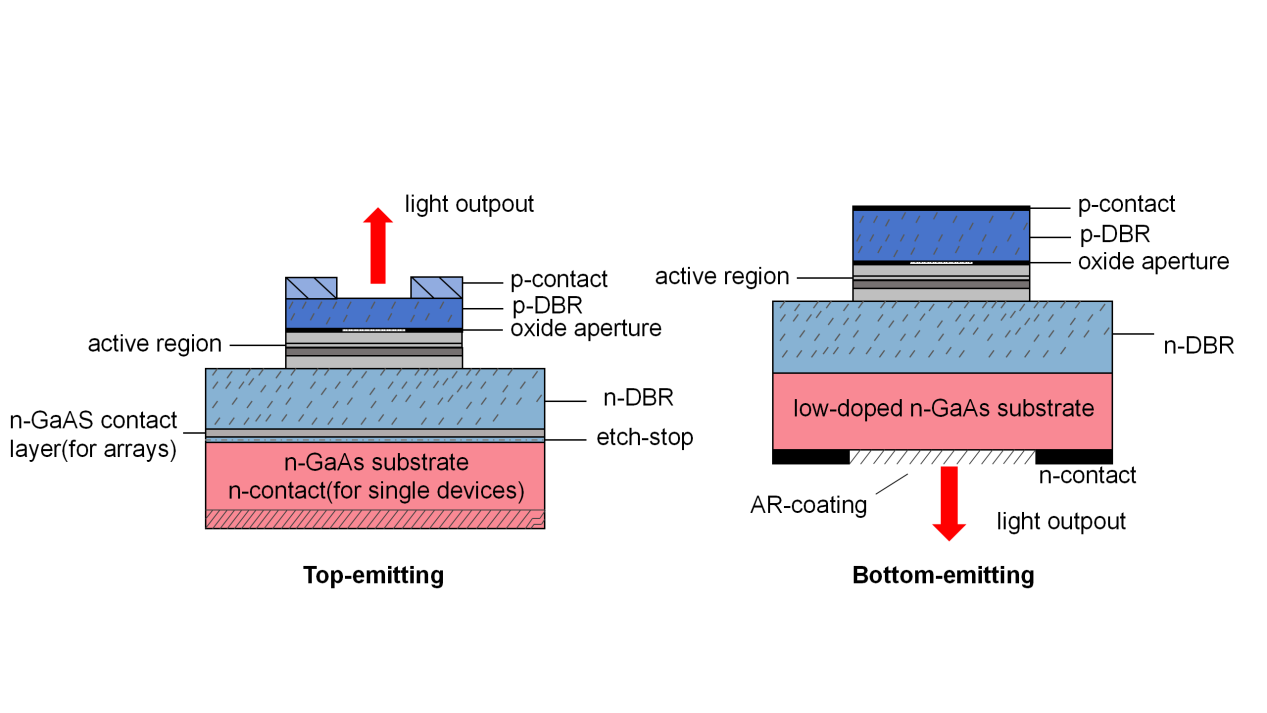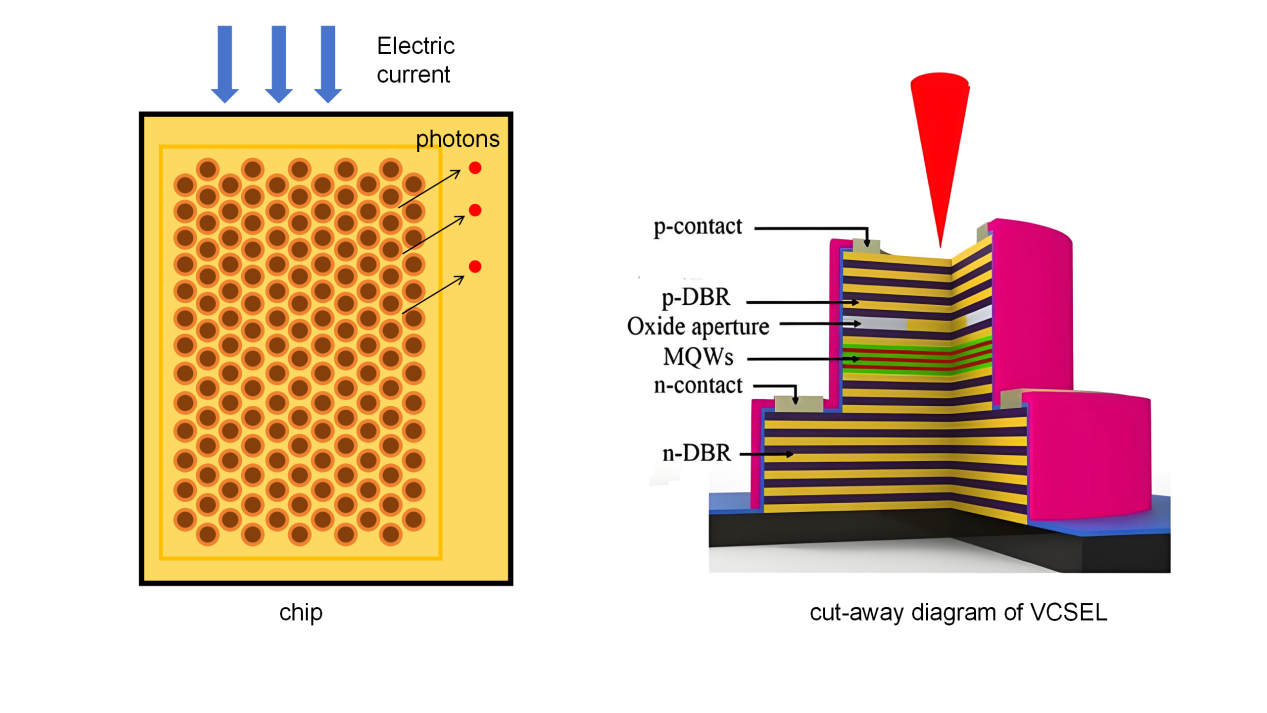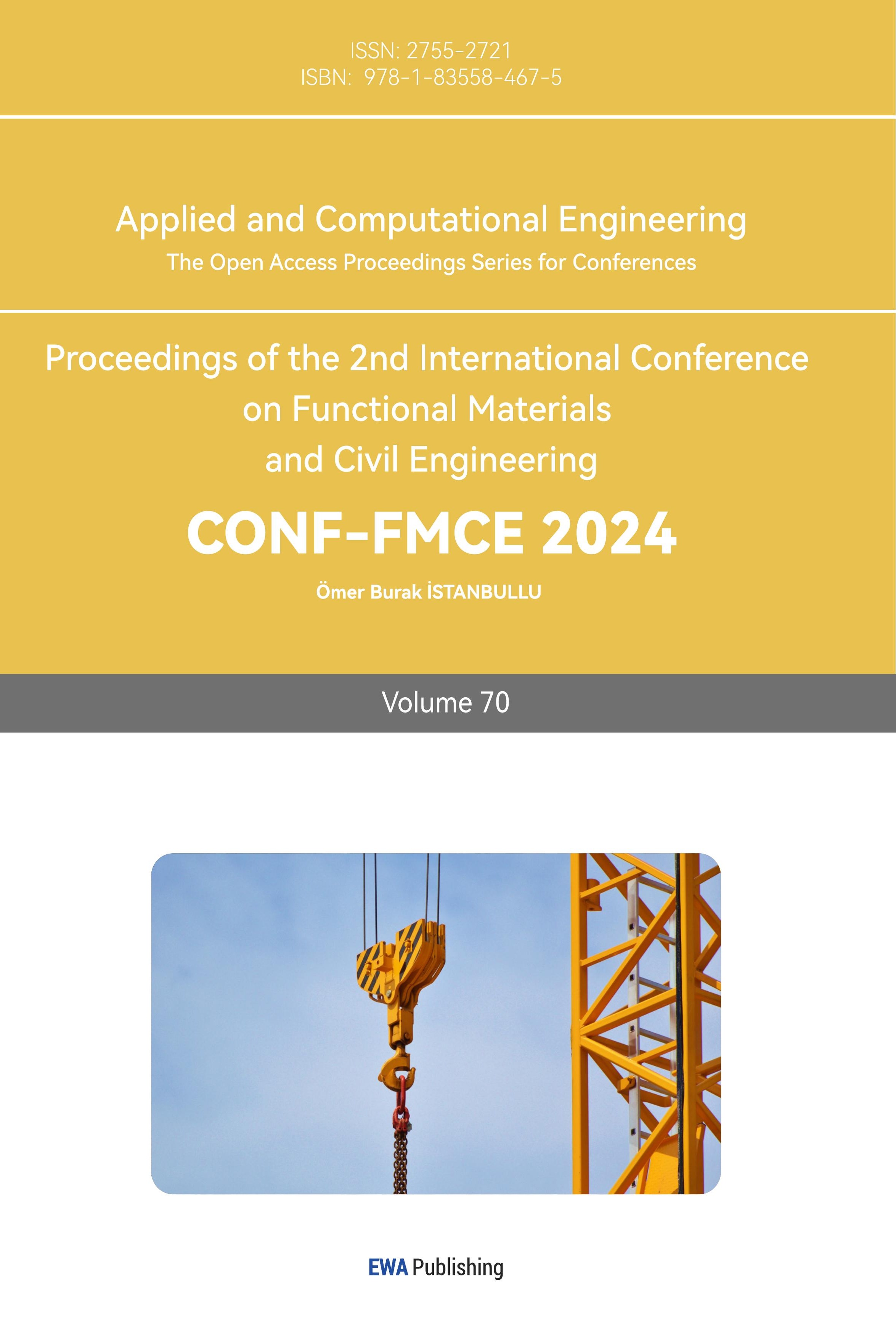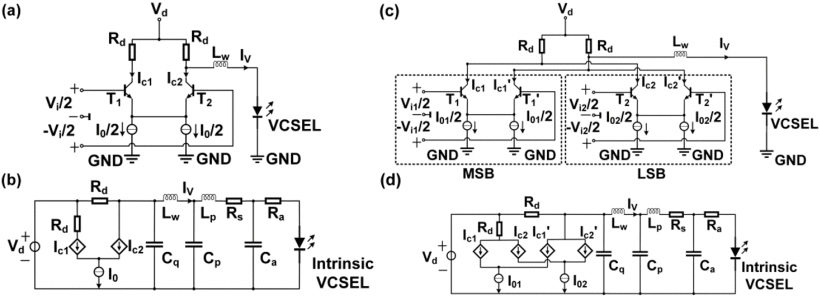1. Introduction
Vertical Cavity Surface Emitting Lasers (VCSEL) have emerged as pivotal components in optical communication systems due to their unique properties and widespread applications. Unlike traditional edge-emitting lasers, VCSEL emits light perpendicular to the surface of the semiconductor chip, enabling easier integration into compact systems and facilitating high-density arrays.
In recent years, the demand for high-speed, low-power, and cost-effective communication solutions has propelled the rapid development and adoption of VCSEL technology in various optical communication applications. In the field of high-speed communication, Sicong Tian et al. realized a high-speed single-mode 940 nm VCSEL with a modulation bandwidth of 27.65 GHz and a transmission rate of 53 Gbit/s by optimizing the VCSEL epitaxial design and growth as well as device design and preparation [1]. Meanwhile, a dual-user high-speed QAM-OFDMA single-input-multiple-output system based on near-infrared VCSEL arrays was firstly proposed by L. Zhang et al [2]. In addition, Cheng Kang et al. tested five stable wavelengths such as 660 nm, 850 nm, and 1310 nm using VCSELs, which provided important data for the study of light source stability [3]. In addition, Ibrahim Hameeda realized a high-speed single-mode VCSEL with a large mode field diameter of up to 10 μm, and successfully enhanced the bandwidth through the coupled-cavity effect [4]. These findings provide an important reference and impetus for the development of VCSEL technology in high-speed communications.
The purpose of this review paper is to provide a comprehensive overview of VCSEL technology in optical communication. It will cover the fundamental principles of VCSEL operation, its various applications, manufacturing processes, performance characteristics, and future trends. With the increasing demand for high-speed data transmission and the proliferation of communication networks, VCSEL technology is poised to play a crucial role in shaping the future of optical communication infrastructure and technology.
2. Principles And Structures Of Vertical Cavity Surface Emitting Lasers
2.1. Conventional Structures
As shown in Fig. 1, the structure of VCSELs is usually categorized into two types: top-emitting and bottom-emitting. Their general fabrication process involves growth on n-type GaAs substrates by metal-organic chemical vapor deposition (MOCVD) technology [5]. It mainly consists of DBRs (laser cavity mirrors), quantum well active regions (MQWs), oxide confinement layer, conductive layer, and substrate. In order to satisfy parameters such as light output conditions and guaranteed output power, the performance of the resonant cavity needs to meet the reflectivity of the total reflector >99.9% and the overall output efficiency >99%. The active region is located between the P-DBR and N-DBR, and the optical thickness should be an integer multiple of the half wavelength in order to form a standing wave during the operation of the VCSEL device, which results in the amplification of the photon energy and thus the formation of excited radiation. Meanwhile, in order to reduce the absorption loss of the substrate, the substrate is usually thinned to below 150 μm and a permeability enhancement film is grown. In addition, the oxide confinement hole which is sandwiched between the DBR reflector and the active region also plays an important role to confine the electric and optical fields and control the spot geometry. Commonly used material systems include InGaAs/GaAs P, where InGaAs is in a compressive strain state and GaAs P can provide strain compensation to address the problem of increasing strain with increasing excitation wavelength and to provide higher gain [6].

Figure 1. Structures of VCSEL
2.2. Working Principles
VCSELs have the three elements of excitation: particle number inversion, pump source and resonant cavity. Its operation is based on several key concepts in semiconductor physics. As current passes through the electrode layer, electrons and holes recombine in the active region of the quantum well to form excitons. These excitons are captured by the quantum well and release energy through a radiation process to produce photons. Subsequently, the photons are continuously reflected in the region from the quantum well to the Bragg mirrors on both sides. Due to the ability of the distributed Bragg mirrors to select specific modes of oscillation, only particular resonant frequencies in the resonant cavity get gained. After the gain is greater than a threshold the photons will be emitted through a light transmission window or notch at the top, creating a laser output. It is worth mentioning that the VCSEL offers great efficiency, low power consumption, and stability due to its exceptionally thin active area thickness and particular resonant cavity architecture.

Figure 2. Schematic diagram of the working process
3. Applications Of VCSEL In Optical Communication
3.1. Optical Communication Status And Challenges
In the past decade, the field of optical communications has witnessed significant advancements through process improvements and the development of new material structures.In 2018, Qinggui Hu’s team increased the coupling efficiency to 48% by designing a receiver with a tapered fiber array. [7] In 2020, Kamalakis Thomas et al. used a mixed-integer genetic algorithm to optimize a multisubwave visible optical communication system [8]. In 2023, Naga Bhaskar Chaluvadi V proposed an optical communication system consisting of cascaded fiber Bragg gratings (FBGs) that can operate in the C-band, which has excellent performance over a distance of 105km [9]. People are moving towards the goal of high rate and wide bandwidth.
However, even though optical communication technology has made some progress, it faces a series of challenges at the same time. As the scale of optical communication systems expands, more light sources and optical paths are introduced into the system, which increases energy consumption and heat generation. Especially in application scenarios such as large-scale data centers [10], effective management of energy consumption and heat becomes an urgent challenge. On the other hand, with the popularization of highly integrated optical path design, light sources need to meet the demands of various array-type structures, such as two-dimensional arrays, linear arrays, etc., in order to meet the needs of different application scenarios. Not only that, the reliability and stability of the communication system are also a focus of attention. In the face of more complex and compact structures, the requirements for optical signals are more stringent in order to ensure the independence and safety of each channel. In response to the above, VCSEL, which is characterized by vertical surface emission, has become the ideal antidote for the continued development of optical communications. As a high-performance, low-power, easy-to-integrate light source, it not only meets the above requirements but also provides more assistance along with process advances.
3.2. Progress Of Vcsel Application In Optical Communication
Over the past decade, vertical cavity surface emitting lasers have become increasingly popular in the field of optical communications. Researchers have promoted the development and application of VCSEL technology through continuous innovation and technological advancement. The following will introduce the research and application of several key achievements in recent years.
In 2016, Angela Amphawan et al. from the School of Science and Technology, Sunway University, Malaysia, explored the impact of radial and azimuthal mode spacings in a 25-channel Mode Division Multiplexing - Wavelength Division Multiplexing system in multimode fiber. Employing a spatial light modulator-controlled VCSEL array to excite Laguerre-Gaussian modes, they achieved a data rate of 25 Gbps at a central wavelength of 1550.12 nm [11].
In 2018, G.M. Isoe from Nelson Mandela University successfully augmented the total aggregated data rate to 60 Gbps by employing a blend of VCSELs, four-level pulse amplitude modulation, dense wavelength division multiplexing, and Raman amplification. Simultaneously, he accomplished a 77.12 km transmission over standard single-mode fiber without relying on traditional signal processing techniques such as forward error correction, equalization, or pre-emphasis [12].
As shown in Figure 3. In 2019, Liang Chenyu’s team proposed a comprehensive co-design framework for power-efficient high-speed VCSEL transmitters targeting 50 Gbaud. The research found similar energy efficiency for over- and under-damped VCSEL-based transmitters under NRZ modulation, with the best energy efficiency at 520.8 fJ/bit. For PAM-4 modulation, the optimized over-damped VCSEL transmitter achieved a 16.13% higher achievable data rate and improved energy efficiency by about 4.12% compared to the under-damped VCSEL transmitter. The best energy efficiencies were 365.1 fJ/bit and 380.8 fJ/bit for the over- and under-damped VCSEL transmitter, respectively, under PAM-4 modulation [13].
In 2020, J. Nanni of the Department of Electrical Engineering conducted a study to explore the potential of utilizing 850 nm VCSELs and Standard Single Mode Fiber (SSMF) in a fiber optic radio system. By studying the noise and nonlinearity of the link and estimating the quality of the received signal. It is shown that SSMF can be considered as one of the first choices for the implementation of 4G and 5G wireless networks [14]. In December of the same year, Wang Hsiao Lun et al. from the University of Illinois investigated the effective modal bandwidth limit of OM4 fiber by characterizing three types of 850 nm oxide-VCSELs: MM, RM, and SM. Their findings proved that low-cost and energy-efficient SM VCSEL-based multimode fiber (MMF) links can extend transmitting distance up to 2 km, making them suitable for use in hyper-scale data centers and high-performance computing environments [15].
In 2022, Armghan Ammar introduced a modified version of VCSEL-based technology using a machine learning (ML) algorithm, which was implemented in Optical Wireless Networks (OWN) for the first time [16].
In the last 2 years, significant advancements in vertical-cavity surface-emitting laser (VCSEL) technology were reported by researchers Jalal Sirwan Kareem and Yun Cheng Yang. Jalal’s study focused on designing a cost-effective downstream radio over fiber system utilizing direct modulation VCSEL optical sources. Their system achieved impressive results, with a maximum output power of 4mW at 20 °C and enabling 5Gbps data transmission up to 100 km for a single user [17]. Meanwhile, Yun Cheng Yang conducted a comprehensive analysis of high-speed performance in 940 nm oxide-confined AlGaAs VCSELs grown on Ge substrates. Their research revealed the superior thermal stability of Ge-based VCSELs, showcasing a maximum modulation bandwidth of 16.1 GHz and successful realization of 25 Gb/s non-return-to-zero (NRZ) transmission at 85 °C [18].
These research results have laid the foundation for the subsequent development of optical communications.
Figure 3. (a) Driver circuit of NRZ signal and (b) the equivalent circuit of NRZ VCSEL transmitter. (c) Driver circuit of PAM-4 signal and (d) the equivalent circuit of PAM-4 VCSEL transmitter. Reprinted with permission from ref. 13. Copyright IEEE Photonics Journal [13].
4. Conclusion
Vertical Cavity Surface Emitting Laser (VCSEL) technology is at the forefront of optical communications development, providing superior solutions to the challenges that plague communications systems. Through careful research and technological innovation, VCSELs have demonstrated impressive performance in all aspects of optical communications, including modulation bandwidths in excess of 35 GHz, single-mode optical signals with transmission rates in excess of 50 Gbps, and new arrays for application in mode division multiplexing (MDM) and wavelength division multiplexing (WDM) systems, among others, opening up new avenues in communications technology.
Furthermore, the widespread adoption of VCSEL technology in optical communication has propelled significant advancements in various application scenarios. From fiber optic radio systems to hyper-scale data centers, VCSELs have demonstrated their versatility and effectiveness in addressing the evolving needs of modern communication networks. Notably, recent breakthroughs in power-efficient transmitters and high-speed performance have underscored the pivotal role of VCSELs in shaping the future of optical communication infrastructure.
In the future, more research will be needed to improve VCSEL performance even more, solve current issues, and investigate new application areas. By overcoming hurdles related to temperature stability, power consumption, and reliability, VCSEL technology can continue to evolve and thrive in diverse communication environments. Moreover, as the demand for high-speed data transmission continues to surge, VCSELs are poised to play an indispensable role in driving the development of next-generation communication systems.
In summary, VCSEL technology holds immense promise for revolutionizing optical communication systems, offering unparalleled advantages in terms of efficiency, performance, and scalability. With ongoing research and innovation, VCSELs are poised to remain at the forefront of optical communication advancements, ushering in a new era of connectivity and innovation in the digital age.
References
[1]. Sicong Tian, Cunzhu Tong, Lijun Wang, et al. (2022) Progress of high-speed vertical-cavity surface-emitting lasers at Changchun Institute of Optical Mechanics. Optics in China. Commun., 15(05): 946-953.
[2]. Cheng Kang, Daijun Qiu, Ruifeng Zhang, et al. (2020) A multi-wavelength stabilized light source for optical transmission based on vertical cavity surface emission. Optical Communication Technology. Commun., 44(09): 30-33.
[3]. Zhang Li, Wei Zixian, Wang Zhaoming, Geng Zuhang, Wei Guodan, Cheng Julian, Fu H.Y., Dong Yuhan. (2021). High-speed multi-user optical wireless communication between VCSEL-integrated electronic devices. Optics Communications. Commun., 486.
[4]. Ibrahim Hameeda, Hassan Ahmed M.A., Koyama Fumio. (2021) High-speed and single-mode 850nm intracavity metal aperture VCSEL with transverse coupled cavity effect. Full use of the Institute of Physics seminar lecture manuscript. Commun., 2021(01): 1073
[5]. Yujiao Li, Nan Zong, Qinjun Peng. (2018) Characteristics and research status of vertical cavity surface emitting semiconductor lasers. Laser & Optoelectronics Progress. Commun., 55(05): 55-67.
[6]. Dengyuan Fu, Lihao Wang, Junyuan Zhao, et al. (2021) Research on long-wavelength vertical cavity surface emitting lasers. Electronic World. Commun., 2021(02): 89-91.
[7]. Qinggui H, Wenguang Long. (2018) Tapered fiber array for space optical communication. Optoelectronics·Laser. Commun 29(12): 1281-1285.
[8]. Kamalakis, T., Dogkas, L., & Simou, F. (2021) Optimization of a discrete multi-tone visible light communication system using a mixed-integer genetic algorithm. Optics Communications. Commun., 485.
[9]. Naga Bhaskar Chaluvadi V, Pal Subhradeep, & Pattnaik Prasant Kumar. (2023). Performance enhancement of optical communication system with cascaded FBGs of varying lengths. Journal of Optics. Commun., 25.
[10]. Hagebeuk, K. (2022). Meeting the Challenges for Space to Earth Optical Communication. NASA Tech Briefs. Commun., 46(9): 7A-9A.
[11]. Amphawan, A., & Fazea, Y. (2016). Laguerre-Gaussian mode division multiplexing in multimode fiber using SLMs in VCSEL arrays. Journal of the European Optical Society-Rapid Publications. Commun., 12.
[12]. Isoe, G.M., Wassin, S., Leitch, A.W.R., & Gibbon, T.B. (2018). 60 Gbps 4-PAM VCSEL-based Raman assisted hyper-scale data centre: In context of spectral efficiency and reach extension. Optics Communications. Commun., 428: 164-168.
[13]. Chenyu, L., Wenjia, Z., & Zuyuan, H. (2019). Electro-Optical Co-Design of Power-Efficient 100-Gbps/λ VCSEL Transmitter. IEEE Photonics Journal. Commun.,11: 1-11.
[14]. Nanni, J., Fernandez, L., Hadi, M. U., Viana, C., Tegegne, Z. G., Polleux, J.-L., & Tartarini, G. (2020). Effect of system dynamics in multi-channel 850 nm VCSEL-based radio-over-G.652 fibre. Electronics Letters. Commun., 56: 385-388.
[15]. Lun, W. H., Junyi, Q., Xin, Y., Wenning, F., & Milton, F. (2020). The Modal Effect of VCSELs on Transmitting Data Rate Over Distance in OM4 Fiber. IEEE Journal of Quantum Electronics. Commun., 56: 1-10.
[16]. Ammar, A., Khaled, A., Farman, A., Fayadh, A., & Meshari, A. (2022). Vertical Cavity Surface Emitting Laser Performance Maturing through Machine Learning for High-Yield Optical Wireless Network. Micromachines. Commun., 13: 2132.
[17]. Kareem, J. S., & Yousif, A. M. R. Z. (2023). Radio over fiber system-based direct modulation VCSEL optical source. Journal of Optics. Commun., 53: 1144-1154.
[18]. Yang, Y. C., Wan, Z., Hsu, G. T., Chiu, C. C., Chen, W. H., Feifel, M., Lackner, D., Xia, G. M., & Wu, C. H. (2024). 25 Gb/s NRZ transmission at 85°C using a high-speed 940 nm AlGaAs oxide-confined VCSEL grown on a Ge substrate. Optics Letters. Commun., 49: 586-589.
Cite this article
He,X. (2024). Vertical Cavity Surface Emitting Laser technology: A comprehensive review. Applied and Computational Engineering,70,188-193.
Data availability
The datasets used and/or analyzed during the current study will be available from the authors upon reasonable request.
Disclaimer/Publisher's Note
The statements, opinions and data contained in all publications are solely those of the individual author(s) and contributor(s) and not of EWA Publishing and/or the editor(s). EWA Publishing and/or the editor(s) disclaim responsibility for any injury to people or property resulting from any ideas, methods, instructions or products referred to in the content.
About volume
Volume title: Proceedings of the 2nd International Conference on Functional Materials and Civil Engineering
© 2024 by the author(s). Licensee EWA Publishing, Oxford, UK. This article is an open access article distributed under the terms and
conditions of the Creative Commons Attribution (CC BY) license. Authors who
publish this series agree to the following terms:
1. Authors retain copyright and grant the series right of first publication with the work simultaneously licensed under a Creative Commons
Attribution License that allows others to share the work with an acknowledgment of the work's authorship and initial publication in this
series.
2. Authors are able to enter into separate, additional contractual arrangements for the non-exclusive distribution of the series's published
version of the work (e.g., post it to an institutional repository or publish it in a book), with an acknowledgment of its initial
publication in this series.
3. Authors are permitted and encouraged to post their work online (e.g., in institutional repositories or on their website) prior to and
during the submission process, as it can lead to productive exchanges, as well as earlier and greater citation of published work (See
Open access policy for details).
References
[1]. Sicong Tian, Cunzhu Tong, Lijun Wang, et al. (2022) Progress of high-speed vertical-cavity surface-emitting lasers at Changchun Institute of Optical Mechanics. Optics in China. Commun., 15(05): 946-953.
[2]. Cheng Kang, Daijun Qiu, Ruifeng Zhang, et al. (2020) A multi-wavelength stabilized light source for optical transmission based on vertical cavity surface emission. Optical Communication Technology. Commun., 44(09): 30-33.
[3]. Zhang Li, Wei Zixian, Wang Zhaoming, Geng Zuhang, Wei Guodan, Cheng Julian, Fu H.Y., Dong Yuhan. (2021). High-speed multi-user optical wireless communication between VCSEL-integrated electronic devices. Optics Communications. Commun., 486.
[4]. Ibrahim Hameeda, Hassan Ahmed M.A., Koyama Fumio. (2021) High-speed and single-mode 850nm intracavity metal aperture VCSEL with transverse coupled cavity effect. Full use of the Institute of Physics seminar lecture manuscript. Commun., 2021(01): 1073
[5]. Yujiao Li, Nan Zong, Qinjun Peng. (2018) Characteristics and research status of vertical cavity surface emitting semiconductor lasers. Laser & Optoelectronics Progress. Commun., 55(05): 55-67.
[6]. Dengyuan Fu, Lihao Wang, Junyuan Zhao, et al. (2021) Research on long-wavelength vertical cavity surface emitting lasers. Electronic World. Commun., 2021(02): 89-91.
[7]. Qinggui H, Wenguang Long. (2018) Tapered fiber array for space optical communication. Optoelectronics·Laser. Commun 29(12): 1281-1285.
[8]. Kamalakis, T., Dogkas, L., & Simou, F. (2021) Optimization of a discrete multi-tone visible light communication system using a mixed-integer genetic algorithm. Optics Communications. Commun., 485.
[9]. Naga Bhaskar Chaluvadi V, Pal Subhradeep, & Pattnaik Prasant Kumar. (2023). Performance enhancement of optical communication system with cascaded FBGs of varying lengths. Journal of Optics. Commun., 25.
[10]. Hagebeuk, K. (2022). Meeting the Challenges for Space to Earth Optical Communication. NASA Tech Briefs. Commun., 46(9): 7A-9A.
[11]. Amphawan, A., & Fazea, Y. (2016). Laguerre-Gaussian mode division multiplexing in multimode fiber using SLMs in VCSEL arrays. Journal of the European Optical Society-Rapid Publications. Commun., 12.
[12]. Isoe, G.M., Wassin, S., Leitch, A.W.R., & Gibbon, T.B. (2018). 60 Gbps 4-PAM VCSEL-based Raman assisted hyper-scale data centre: In context of spectral efficiency and reach extension. Optics Communications. Commun., 428: 164-168.
[13]. Chenyu, L., Wenjia, Z., & Zuyuan, H. (2019). Electro-Optical Co-Design of Power-Efficient 100-Gbps/λ VCSEL Transmitter. IEEE Photonics Journal. Commun.,11: 1-11.
[14]. Nanni, J., Fernandez, L., Hadi, M. U., Viana, C., Tegegne, Z. G., Polleux, J.-L., & Tartarini, G. (2020). Effect of system dynamics in multi-channel 850 nm VCSEL-based radio-over-G.652 fibre. Electronics Letters. Commun., 56: 385-388.
[15]. Lun, W. H., Junyi, Q., Xin, Y., Wenning, F., & Milton, F. (2020). The Modal Effect of VCSELs on Transmitting Data Rate Over Distance in OM4 Fiber. IEEE Journal of Quantum Electronics. Commun., 56: 1-10.
[16]. Ammar, A., Khaled, A., Farman, A., Fayadh, A., & Meshari, A. (2022). Vertical Cavity Surface Emitting Laser Performance Maturing through Machine Learning for High-Yield Optical Wireless Network. Micromachines. Commun., 13: 2132.
[17]. Kareem, J. S., & Yousif, A. M. R. Z. (2023). Radio over fiber system-based direct modulation VCSEL optical source. Journal of Optics. Commun., 53: 1144-1154.
[18]. Yang, Y. C., Wan, Z., Hsu, G. T., Chiu, C. C., Chen, W. H., Feifel, M., Lackner, D., Xia, G. M., & Wu, C. H. (2024). 25 Gb/s NRZ transmission at 85°C using a high-speed 940 nm AlGaAs oxide-confined VCSEL grown on a Ge substrate. Optics Letters. Commun., 49: 586-589.










